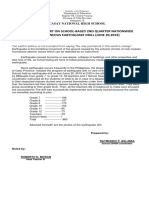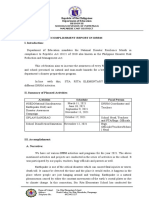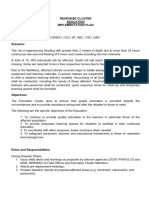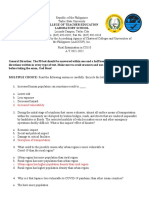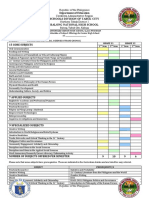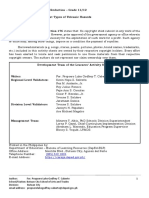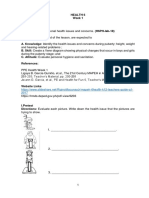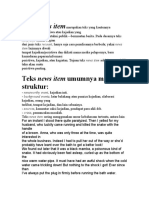Learning Objective:: Good Practices For DRR
Learning Objective:: Good Practices For DRR
Uploaded by
Shekaina Faith LozadaOriginal Description:
Original Title
Copyright
Available Formats
Share this document
Did you find this document useful?
Is this content inappropriate?
Report this DocumentCopyright:
Available Formats
Learning Objective:: Good Practices For DRR
Learning Objective:: Good Practices For DRR
Uploaded by
Shekaina Faith LozadaCopyright:
Available Formats
WEEKLY LEARNING ACTIVITY SHEETS
Disaster Readiness and Risk Reduction, Quarter 2, Week 7
COMMUNITY-BASED DISASTER RISK REDUCTION AND MANAGEMENT
Name: ___________________________________________ Section: ____________________
Most Essential Learning Competencies:
The learners are able to:
• discuss differently community-based practices for managing disaster risk to
specific hazards (DRR11/12-Iig-h-44)
• develop a community preparedness plan (DRR11/12-Iig-h-45)
Learning Objective:
At the end of the lesson, the learners will be able to:
1. identify the four themes in disaster risk reduction management framework that will
help them in creating their own community preparedness plans;
2. make an infographic about Disaster Preparedness Plan by integrating the four (4)
thematic area of DRRR management; and
3. appreciate the importance of creating a Disaster Preparedness Plan.
Key Concepts:
Lesson 1: Best Practices
Good Practices for DRR
In this lecture, two (2) initiatives done in different parts of the world are presented. These are
considered good practices, they provide an indication of the success achieved so far and an idea
of what could be achieved in the future.
Two projects in promoting prevention.
1. Children Assess their Own Vulnerabilities, Plan Risk Reduction (Philippines)
2. Annual “Earthquake and Safety” Drills in all Schools across the Country
CHILDREN ASSESS THEIR OWN VULNERABILITIES, PLAN RISK REDUCTION
(PHILIPPINES)
More than half of the population at risk in the Philippines
is children, yet their specific vulnerabilities, needs and
capacities have not been addressed, nor has their
potential role in disaster risk reduction (DRR) been
recognized. To address this, a project called “Child-
Oriented
Participatory Risk Assessment and Planning” (COPRAP)
was implemented. The project promoted disaster
planning for children through development of tools that
help children identify their own needs, vulnerabilities
Image source:
and capacities. Subsequently, the community adopted
https://www.worldvision.org.ph/news/child-
DRR measures that benefited both the children and the
focused-disaster-risk-reduction-and-
rest of the community. More importantly, the Project
management/
paved the way for local-level initiatives towards an
integrated and sustainable approach to development.
1
Author: Ma. Isabel Katrina N. Borja
School/Station: Butuan City School of Arts and Trades
Division: Butuan City Division
email address: maisabelkatrina.borja@deped.gov.ph
IMPACTS LESSON LEARNED
• The project was sustainable and it paved • Children can play specific roles before, during
the way for local level initiatives toward an and after a disaster such as preparation of
integrated and sustainable approach to supplies or other basic needs
development. • In addition to food and clothing, children have a
• It debunked the notion that disaster primary need for educational material such as
management is solely the responsibility of books, bags, pencils and notebooks.
adults • Questionnaires and activities help understand
the needs of a community before, during and after
a disaster.
ANNUAL “EARTHQUAKE AND SAFETY” DRILLS IN ALL SCHOOLS ACROSS THE
COUNTRY
Iran has sought to educate children and youngsters
on disaster preparedness at all school levels on a
national scale, in both urban and rural areas.
“Earthquake and Safety” programs have been carried
out in the country since 1991 by the Iran-based
International Institute of Earthquake Engineering
and Seismology (IIEES), and school safety programs
have been under way since 1996. The Initiative, called
“Earthquake and Safety Drills in Schools”, is part of a
series of activities aimed at protecting people,
especially children, from the impacts of future
earthquakes. The Initiative also involves developing
Image source: https://www.philstar.com/the-
and implementing a comprehensive program that
freeman/cebu- addresses all groups in society.
news/2017/07/30/1723194/disaster-
preparedness-now-part-school-curriculum
IMPACTS LESSON LEARNED
• The drills have helped expand a seismic • Education plays a key role in promoting safety
safety culture, spread the “drill” experience measures against earthquakes and spreading
to non-school areas, and make them in the society.
“Earthquake and Safety” a national activity. • A major challenge initially was to secure the
• Promotes a culture of safety at all levels of cooperation of many institutions and
society organizations such as mass media. This was
• Increase children’s knowledge, and share overcome through persistent advocacy and
this knowledge with their families, friends continuous follow-up to secure cooperation of
and community. many institutions.
Author: Ma. Isabel Katrina N. Borja
School/Station: Butuan City School of Arts and Trades
Division: Butuan City Division
email address: maisabelkatrina.borja@deped.gov.ph
Lesson 2: Development of Community Preparedness Plan
Four (4) themes in disaster risk reduction management framework.
Image source: https://slideplayer.com/slide/5295723/
EVALUATION
PREVENTION REHABILITATION PREVENTION
AND PREPAREDNESS RESPONSE AND RECOVERY AND
MITIGATION MITIGATION
Disaster risk reduction in national
and local plans and programs.
Hazard and risk mapping.
Activities related to ensuring the
(a) people are prepared and
(b) response will be carried out
efficiently and effectively
Restoration of life lines and basic
infrastructure. Early recovery
Long term recovery and prevention
and mitigation – “building back better
Author: Ma. Isabel Katrina N. Borja
School/Station: Butuan City School of Arts and Trades
Division: Butuan City Division
email address: maisabelkatrina.borja@deped.gov.ph
DISASTER PREVENTION AND MITIGATION
DEPARTMENT OF GOAL: Avoid hazards and mitigate their potential impacts by
SCIENCE AND reducing vulnerabilities and exposure and enhancing capacities
TECHNOLOGY of communities
• Reduce vulnerabilities and exposure of communities to health
hazards
• Enhance capacities of communities to reduce their own risks
and cope with the impacts of all hazards
DISASTER PREPAREDNESS
GOAL: Establish and strengthen capacities of communities to
anticipate, cope and recover from the negative impacts of
DEPARTMENT OF THE emergency occurrences and disasters
INTERIOR AND LOCAL • Increase level of awareness of the community to threats and
GOVERNMENT impacts of all hazards
• Equip the community with necessary skills to cope with the
negative impacts of a disaster
• Increase the capacity of a community
• Develop and implement disaster preparedness policies and
plans
• Strengthen partnership among all key stakeholders
DISASTER RESPONSE
DEPARTMENT OF GOAL: Provide life preservation and meet the basic subsistence
SOCIAL WELFARE AND needs of affected population based in acceptable standards
DEVELOPMENT during or immediately after a disaster
1. Decrease the number of preventable deaths and injuries
2. Provide basic subsistence needs of affected population
3. Immediately restore basic social services
DISASTER REHABILITATION AND RECOVERY
NATIONAL ECONOMIC GOAL: Restore and improve facilities, livelihood and living
AND DEVELOPMENT conditions and organization capacities of affected
AUTHORITY communities, and reduce disaster risks in accordance with the
”build back better” principle
1. Restore people’s means of livelihood and continuity of
economic activities
2. Restore shelter and other installations
3. Reconstruct infrastructure and other public utilities
4. Assist in the physical and psychological rehabilitation of
persons who suffered from the effects of disaster
Author: Ma. Isabel Katrina N. Borja
School/Station: Butuan City School of Arts and Trades
Division: Butuan City Division
email address: maisabelkatrina.borja@deped.gov.ph
Activity 1. Survey time.
What you need: Separate sheet of paper, sample survey questionnaires, pen
What to do: Conduct a survey and use the guide survey questions below to gather
information and data from your community/barangay about their Disaster Preparedness
Best-Practices. The data gathered will be used for the next activity.
Survey Questionnaires.
Author: Ma. Isabel Katrina N. Borja
School/Station: Butuan City School of Arts and Trades
Division: Butuan City Division
email address: maisabelkatrina.borja@deped.gov.ph
Activity 2. Have a Collab!
What you need: separate sheet of paper, Sample survey questionnaires, pen
What to do: Based on the survey, collaborate with your classmate through text or call on the
best-practices of their barangay in terms of Disaster Preparedness.
Guide Questions:
1. What are the best-practices you have learned from the other community? _________________
________________________________________________________________________________________
_______________________________________________________________________________________.
2. Based on your sharing, how would you improve the DRRM practices in your community?
________________________________________________________________________________________
_______________________________________________________________________________________.
3. How does COVID-19 pandemic affects the disaster preparedness practices of the
communities? __________________________________________________________________________
________________________________________________________________________________________
_______________________________________________________________________________________.
Activity 3. Infographic Disaster Preparedness Plan.
What you need: separate sheet of paper, pen
What to do: With the thematic areas in mind, formulate an Infographic Disaster Plan in your
community/barangay by thinking an activity in each thematic area (Preparedness,
Prevention & Mitigation, Response and Rehabilitation & Recovery) that can be locally
done for a common hazard. Make use of available materials and resources that can be found
in your home. Below are examples of Infographics about disaster plan. Dimension is 8.5
inches by 13 inches portrait or equivalent to a long bond paper.
Image source: Image source:
https://www.allstatenewsroom.com/ https://in.pinterest.com/pin/105271710014126579/ 6
Author: Ma. Isabel Katrina N. Borja
School/Station: Butuan City School of Arts and Trades
Division: Butuan City Division
email address: maisabelkatrina.borja@deped.gov.ph
Rubric in Assessing Activity 2: Infographic Disaster Plan
4 3 2 1 0
Lay out is
organized Layout could
Layout is
and uses use
Generally good disorganized,
consistent improvement. No layout or
Design layout. Has no obvious
style. Color Two or more scheme –
(Layout, minor organization.
scheme has inconsistent just random
Color inconsistency or Layout
visual appeal elements. elements,
Scheme, one distracting distracts
and works Hard to read colors and
Fonts) element. Color from content.
with content. fonts. Layout fonts.
scheme clashes Color scheme
Fonts are distracts from
is confusing.
legible and content.
consistent
One or two Not enough
Appropriate
thematic areas application of
Content application of Lacking in
used incorrectly the four (4)
(Application the four (4) application of
or without thematic
of the DRRR the content.
explanation. areas. Data is
thematic thematic Not enough No real data
Adequate sparse. Data
areas, areas. More facts or data. of facts are
amount of data. might not
Quality of than enough Data is from present
Data demonstrate
Data, data to make poor or
demonstrate the trend or
Quantity of claims. Data questionable
trend, claim. claim. Data
Data from good source.
Data from good from good
source.
sources. sources.
Claim and
main idea is
obvious and
easy to
Clarity Claim, main Claim, main
understand. Infographic
(Makes a idea is idea is made.
No makes a poor Claim, main
claim, understandable. Some
unnecessary initial idea is
Efficiency, No unnecessary graphics or
graphic or impression. missing
Makes clear graphics or visuals are
visuals. Confusing
impression visuals unneeded
Infographic
makes a good
initial
impression
Reflection:
Give the importance of creating a disaster preparedness plan in your own home. Write your
5-sentence answer in a separate sheet of paper.
Rubrics:
3 – Practical application is scientifically explained consistent to the concepts, and
has no misconception
2 - Practical application is scientifically explained consistent to the concepts, but
with minimal misconception
1 - Practical application is scientifically explained consistent to the concepts, but
with misconception
0 – No discussion
7
Author: Ma. Isabel Katrina N. Borja
School/Station: Butuan City School of Arts and Trades
Division: Butuan City Division
email address: maisabelkatrina.borja@deped.gov.ph
Reference:
Commission on Higher Education (CHED). 2016 Disaster Risk Reduction Management.
Quezon City. Commission on Higher Education.
https://www.researchgate.net/figure/Major-questions-asked-to-the-students-in-the-
questionnaire-survey_fig8_264244417
Author: Ma. Isabel Katrina N. Borja
School/Station: Butuan City School of Arts and Trades
Division: Butuan City Division
email address: maisabelkatrina.borja@deped.gov.ph
You might also like
- Fiasco - Engine DeckDocument14 pagesFiasco - Engine DeckGieF 1995No ratings yet
- Presentation - School-Based DRRMDocument35 pagesPresentation - School-Based DRRMjuliamarkNo ratings yet
- Division of Batangas DRRM Monitoring - Tool 2019 EditedDocument12 pagesDivision of Batangas DRRM Monitoring - Tool 2019 EditedjoelNo ratings yet
- Failure of Foundation Due To EarthquakeDocument20 pagesFailure of Foundation Due To EarthquakeKuldeep Kumar83% (6)
- Bombing Contingency Plan (Final) PDFDocument22 pagesBombing Contingency Plan (Final) PDFRodgelyn Francisco100% (1)
- DRRR Hand Out 15Document5 pagesDRRR Hand Out 15Angela CadanoNo ratings yet
- S5 Development of DRRM and Mitigation Extension ProgramDocument16 pagesS5 Development of DRRM and Mitigation Extension ProgramShirley Jean Villamor SuganoNo ratings yet
- ACR On Project DREAMDocument6 pagesACR On Project DREAMApril Joy ValdezNo ratings yet
- Post TestDocument4 pagesPost TestLeanne GomezNo ratings yet
- Integrating Disaster Risk Reduction Into School Curriculum, Mainstreaming Disaster Risk Into EducationDocument23 pagesIntegrating Disaster Risk Reduction Into School Curriculum, Mainstreaming Disaster Risk Into EducationEric Sayritan100% (1)
- Module 2 - CP FactorsDocument34 pagesModule 2 - CP Factorsmichaeljohnranada1987No ratings yet
- Student-Led School Watching and Hazard Mapping Action PlanDocument2 pagesStudent-Led School Watching and Hazard Mapping Action PlanJenelyn Jamahali0% (1)
- DRRRDocument20 pagesDRRRKiara Denise SuarezNo ratings yet
- Sample Earthquake Drill ReportDocument11 pagesSample Earthquake Drill ReportApolinario Mariscal0% (1)
- LP DRRRDocument2 pagesLP DRRRjuliet ferrer100% (1)
- Zaragoza NHS CP - EarthquakeDocument38 pagesZaragoza NHS CP - Earthquakewyan cena100% (1)
- DLP DRR LC 24Document3 pagesDLP DRR LC 24allanrnmanaloto100% (1)
- Mces-Contingency-Plan For Natural and Human Induced HazardsDocument19 pagesMces-Contingency-Plan For Natural and Human Induced HazardsMAYETTE PAYABAN100% (1)
- Staritaes DRRM ArDocument4 pagesStaritaes DRRM ArRHEA MARIE REYESNo ratings yet
- Chapter 2 Identifying Specific VulnerabilitesDocument12 pagesChapter 2 Identifying Specific VulnerabilitesallanrnmanalotoNo ratings yet
- Subject Matter Skills and Competencies Code No. of Days Remarks Signature of School HeadDocument4 pagesSubject Matter Skills and Competencies Code No. of Days Remarks Signature of School HeadRhio Cuevas Amor100% (1)
- Narrative Report On DRRM 4 Quarter Nationwide Simultaneous Earthquake Drill S.Y 2020-2021Document4 pagesNarrative Report On DRRM 4 Quarter Nationwide Simultaneous Earthquake Drill S.Y 2020-2021Mark Jay BongolanNo ratings yet
- Recommendations To Improve The Barangay DRRM PlanDocument1 pageRecommendations To Improve The Barangay DRRM PlanAileen BlancaflorNo ratings yet
- Daily Lesson LOG: School: Grade Level: Teacher: Learning Areas: Teaching Week QuarterDocument3 pagesDaily Lesson LOG: School: Grade Level: Teacher: Learning Areas: Teaching Week QuarterKennedy Fieldad VagayNo ratings yet
- Cy 2019 NsedDocument3 pagesCy 2019 NsedEric Doroja MabesaNo ratings yet
- SDRRM Pictorial Narrative 3RD QUARTERDocument2 pagesSDRRM Pictorial Narrative 3RD QUARTERKaye Mcforest CaoleNo ratings yet
- Template Family Earthquake Preparedness Homework Results and SummaryDocument4 pagesTemplate Family Earthquake Preparedness Homework Results and SummarySteven Supan100% (1)
- Constitution and BylawsDocument7 pagesConstitution and BylawsNiña Gel Gomez Aparecio100% (1)
- DRRM Orientation and Coordination Meeting Private SchoolsDocument54 pagesDRRM Orientation and Coordination Meeting Private Schoolsecardnyl25No ratings yet
- Colon Student-Led School Watching and Hazard MappingDocument9 pagesColon Student-Led School Watching and Hazard MappingMariel VillanuevaNo ratings yet
- RESPONSE CLUSTER Education ImplanDocument10 pagesRESPONSE CLUSTER Education ImplanARCHIE AJIASNo ratings yet
- WorkPlan-SDRRM-Team Brigada KKK-2021Document5 pagesWorkPlan-SDRRM-Team Brigada KKK-2021Cris Noel AureNo ratings yet
- NDRMM Narrative 2017 1Document8 pagesNDRMM Narrative 2017 1Joel Fernandez100% (1)
- PROJECT PROPOSAL - Team BLDGDocument3 pagesPROJECT PROPOSAL - Team BLDGJelyn Dela TorreNo ratings yet
- DRRR POWERPOINT Types of HazardsDocument19 pagesDRRR POWERPOINT Types of HazardsKelsey Gaile MaghanoyNo ratings yet
- DRRM Plan2020 2021Document5 pagesDRRM Plan2020 2021SheChanNo ratings yet
- Ariston Sample Contengency PlanDocument27 pagesAriston Sample Contengency PlanHope Rogen TiongcoNo ratings yet
- Midterm Examination: Disaster Readiness and Risk ReductionDocument3 pagesMidterm Examination: Disaster Readiness and Risk ReductionHarold Nalla Husayan100% (1)
- Module - Hazard Guessing GameDocument21 pagesModule - Hazard Guessing GameDNiel Gonzales BautistaNo ratings yet
- DRRM PresenattionDocument22 pagesDRRM PresenattionjuliamarkNo ratings yet
- SDRRM Action Pla Draft PatternDocument4 pagesSDRRM Action Pla Draft PatternMaria Louella Casalme Floro100% (1)
- Final Examination in Cs110 - DRRR - Answer KeyDocument10 pagesFinal Examination in Cs110 - DRRR - Answer KeyPrincess Ira SantillanNo ratings yet
- SDRRM Midyear Acr - Balagtas NahsDocument4 pagesSDRRM Midyear Acr - Balagtas NahsRyan RiveraNo ratings yet
- Final DRRM Project DreamDocument8 pagesFinal DRRM Project DreamAndreRicamaraNo ratings yet
- Key Players in Disaster Risk Reduction and Management: DR & RR 11Document3 pagesKey Players in Disaster Risk Reduction and Management: DR & RR 11jessafesalazarNo ratings yet
- Earthquake Drill NarrativeDocument1 pageEarthquake Drill NarrativeJoseph Ferreras-Guardian Eva-Escober100% (1)
- DRRM Plan 2022-2023Document3 pagesDRRM Plan 2022-2023Caabas LeenardNo ratings yet
- Module 3 Emergency Preparedness and Response ManagementDocument13 pagesModule 3 Emergency Preparedness and Response ManagementMa. AlbinaNo ratings yet
- Table of Specification Disaster Readiness and Risk Reduction 2nd Semester FINAL EXAMDocument2 pagesTable of Specification Disaster Readiness and Risk Reduction 2nd Semester FINAL EXAMRICHARD CORTEZNo ratings yet
- Department of Education Schools Division of Tabuk City Balong National High SchoolDocument4 pagesDepartment of Education Schools Division of Tabuk City Balong National High SchoolLino Anthony BanataoNo ratings yet
- Acr InsetDocument2 pagesAcr InsetMaestro GallaNo ratings yet
- Annex 3 - DepEd Contingency Planning Guide - 20190827Document7 pagesAnnex 3 - DepEd Contingency Planning Guide - 20190827Winzette Roldan-Fie BalaisNo ratings yet
- DRRR - Q2 - Summative 3Document4 pagesDRRR - Q2 - Summative 3Billy Jasper DomingoNo ratings yet
- Disaster-Risk-Reduction Final Exam 2020 Grade11 The OrigDocument2 pagesDisaster-Risk-Reduction Final Exam 2020 Grade11 The OrigelmerdlpNo ratings yet
- DRRR Q2 Exam 20 ItemsDocument2 pagesDRRR Q2 Exam 20 ItemsJeffrey OralizaNo ratings yet
- Phases of An Earthquake Drill: Phase 1. AlarmDocument7 pagesPhases of An Earthquake Drill: Phase 1. AlarmSamSamEstoqueNo ratings yet
- Reviewer For DRR Quiz BeeDocument2 pagesReviewer For DRR Quiz Bee「 」100% (1)
- 20th Gawad KalasagDocument5 pages20th Gawad KalasagTheresa Marie CarreonNo ratings yet
- Acr-Earthquake DrillDocument3 pagesAcr-Earthquake DrillLeah Jane Chiu MorilloNo ratings yet
- Felisa Villoria Bond Memorial School: Teacher I/School DRRM CoordinatorDocument12 pagesFelisa Villoria Bond Memorial School: Teacher I/School DRRM CoordinatorSARAH JEAN CABUGNASONNo ratings yet
- DRRM FIRST Quarter Narrative Report February 2019Document5 pagesDRRM FIRST Quarter Narrative Report February 2019Rizza Mae Sarmiento Bagsican100% (3)
- Group 9 DRRRDocument5 pagesGroup 9 DRRRanniebcortez8801No ratings yet
- DRRR - Q1 - Week 7aDocument16 pagesDRRR - Q1 - Week 7aShekaina Faith Lozada100% (2)
- DRRR - Q1 - Week 7bDocument15 pagesDRRR - Q1 - Week 7bShekaina Faith LozadaNo ratings yet
- Most Essential Learning CompetenciesDocument9 pagesMost Essential Learning CompetenciesShekaina Faith LozadaNo ratings yet
- Lesson Plan in Grade 11 - Stem Earth Science: I. OBJECTIVES (Layunin) A. Content StandardDocument10 pagesLesson Plan in Grade 11 - Stem Earth Science: I. OBJECTIVES (Layunin) A. Content StandardShekaina Faith Lozada100% (1)
- DRRR - Q2 - Week 6Document5 pagesDRRR - Q2 - Week 6Shekaina Faith LozadaNo ratings yet
- Learning Activity Sheet Science 6 Week 1 CompetenciesDocument8 pagesLearning Activity Sheet Science 6 Week 1 CompetenciesShekaina Faith LozadaNo ratings yet
- Assesses Regularly Participation in Physical Activities Based On The Philippine Physical Activity Pyramid (PE6PF-Ib-h-18)Document10 pagesAssesses Regularly Participation in Physical Activities Based On The Philippine Physical Activity Pyramid (PE6PF-Ib-h-18)Shekaina Faith Lozada100% (2)
- Music 6 - Week 1 - EditedDocument6 pagesMusic 6 - Week 1 - EditedShekaina Faith LozadaNo ratings yet
- Weekly Home Learning Plan For Grade 12 - STEM Week No.: 5 Quarter No.: 2 Quarter Date: January 10-14, 2022Document3 pagesWeekly Home Learning Plan For Grade 12 - STEM Week No.: 5 Quarter No.: 2 Quarter Date: January 10-14, 2022Shekaina Faith LozadaNo ratings yet
- Health 6 Q1 - Week 1 EditedDocument9 pagesHealth 6 Q1 - Week 1 EditedShekaina Faith LozadaNo ratings yet
- Weekly Home Learning Plan For Grade 12 - STEM Week No.: 2 Quarter No.: 2 Quarter Date: November 29-December 3, 2021Document2 pagesWeekly Home Learning Plan For Grade 12 - STEM Week No.: 2 Quarter No.: 2 Quarter Date: November 29-December 3, 2021Shekaina Faith LozadaNo ratings yet
- Components of Drama and Oedipus Rex As ExampleDocument3 pagesComponents of Drama and Oedipus Rex As ExampleAmir Khan VlogsNo ratings yet
- QAS BDRRM Plan Template - EnglishDocument45 pagesQAS BDRRM Plan Template - EnglishNico & Hope SoNo ratings yet
- Mes Fire Contigency Plan Canlaon TemplateDocument26 pagesMes Fire Contigency Plan Canlaon TemplateElvira Sitoy TagactacNo ratings yet
- Teks News Item: Merupakan Teks Yang KontennyaDocument4 pagesTeks News Item: Merupakan Teks Yang KontennyaZurneva RosyNo ratings yet
- Ibu Foundation Profiles 2020-2024Document16 pagesIbu Foundation Profiles 2020-2024api-259362397No ratings yet
- Module 3 VulnerabilitiesDocument7 pagesModule 3 VulnerabilitiesFaizal Bazeron100% (1)
- Typhoon For BrochureDocument3 pagesTyphoon For BrochureLovely Venia JovenNo ratings yet
- Major Reference Works (MRW) Contribution DetailsDocument3 pagesMajor Reference Works (MRW) Contribution Detailssubrata895 subrata895No ratings yet
- Cloudburst: Kumar Prafull 06AR1003 Ranjitha Shivaram 06AR1004Document19 pagesCloudburst: Kumar Prafull 06AR1003 Ranjitha Shivaram 06AR1004Shobana SanthanagopalanNo ratings yet
- TANATE - Module 4 - EssayDocument2 pagesTANATE - Module 4 - EssayDave SagubanNo ratings yet
- Basic Concept of HazardDocument12 pagesBasic Concept of HazardKrith Alexi DaramanNo ratings yet
- Town of Brighton Big Cottonwood Canyon Emergency Operations PlanDocument22 pagesTown of Brighton Big Cottonwood Canyon Emergency Operations Planapi-343650991No ratings yet
- Once Upon A Time in Tana TorajaDocument3 pagesOnce Upon A Time in Tana TorajakurniNo ratings yet
- TV News Story FormatsDocument8 pagesTV News Story FormatsSilky Sharan100% (2)
- 1994 Norton Et Al - Northridge Earthquake Reconnaissance ReportDocument110 pages1994 Norton Et Al - Northridge Earthquake Reconnaissance ReportAKNo ratings yet
- Q4 Science 6 Week2Document4 pagesQ4 Science 6 Week2Reniel Sabaco100% (1)
- CM - MAN.MLR - Manuals, Logs and RecordsDocument2 pagesCM - MAN.MLR - Manuals, Logs and RecordsSergiu DarieNo ratings yet
- CREST 2023 Bulletin EnglishDocument4 pagesCREST 2023 Bulletin EnglishAdriel ElezarNo ratings yet
- GE8071 Disaster ManagementDocument10 pagesGE8071 Disaster ManagementAnonymous dIhhKA0% (1)
- (Big Cities) To Peripheries (Regions, Provinces, and Small Towns) ?Document3 pages(Big Cities) To Peripheries (Regions, Provinces, and Small Towns) ?lyzaNo ratings yet
- Crim 6Document32 pagesCrim 6milet gatanNo ratings yet
- Science: Modified Strategic Intervention MaterialsDocument20 pagesScience: Modified Strategic Intervention MaterialsrodalynjoydizonNo ratings yet
- Slide Gempa BumiDocument89 pagesSlide Gempa BumiStamfordNaturalNo ratings yet
- 21st Poem, DRRR ArticlesDocument3 pages21st Poem, DRRR ArticlesCluver Aedrian AmodiaNo ratings yet
- Talugtug CPDocument54 pagesTalugtug CPEmerson AngellanoNo ratings yet
- BSCE 4A GroupG PrelimMidtermFinalDocument29 pagesBSCE 4A GroupG PrelimMidtermFinalAlvin ConcepcionNo ratings yet
- The Impact of Social Media On Langkaan 1 Residents During A National DisasterDocument14 pagesThe Impact of Social Media On Langkaan 1 Residents During A National DisasterJohnpeter LopezNo ratings yet













